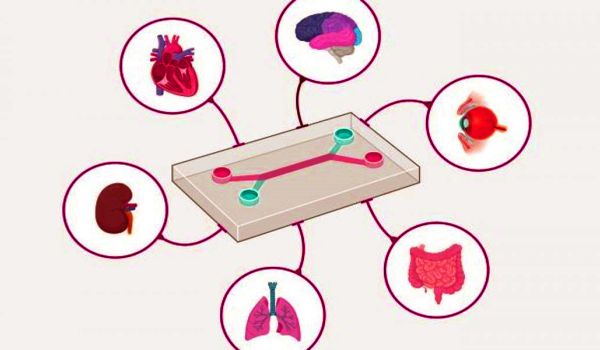The organ chips are designed to accurately recreate the natural physiology and mechanical forces that cells experience in the human body. An organ-on-a-chip (OOC) is a multi-channel 3-D microfluidic cell culture chip that simulates the activities, mechanics, and physiological response of entire organs and organ systems, a type of artificial organ. The chips are lined with living human cells and their tiny fluidic channels reproduce blood and/or airflow just as in the human body. It constitutes the subject matter of significant biomedical engineering research, more precisely in bio-MEMS. Their flexibility allows the chips to recreate breathing motions or undergo muscle contractions.
The convergence of labs-on-chips (LOCs) and cell biology has permitted the study of human physiology in an organ-specific context, introducing a novel model of in vitro multicellular human organisms. Each organ chip, such as the lung, liver, intestine, or brain, is about the size of a AA battery. One day, they will perhaps abolish the need for animals in drug development and toxin testing. The chip’s transparency allows researchers to see the organ’s functionality, behavior, and response, at the cellular and molecular level.

The organ chips are placed into a research system similar to a computer. Although multiple publications claim to have translated organ functions onto this interface, the movement towards this microfluidic application is still in its infancy. The instrument is designed to recreate the human body’s living environment – including blood flow and breathing motions. Organ on-chip research already allowed to creation of many microfluidic chips that can partially simulate organ function: liver, lungs, gut, etc., and even tumors on-chip.
Organs-on-chips will vary in design and approach between different researchers. As such, validation and optimization of these systems will likely be a long process. Scientists can use modular instruments to introduce medicines, chemicals, and other toxins to the chip’s environment to test the organ’s response and behavior. Organs that have been simulated by microfluidic devices include the heart, the lung, kidney, artery, bone, cartilage, skin, and more. The modular nature of the system allows scientists to observe and analyze the cells within the organ chips using a variety of research tools and instrumentation.
Nevertheless, building valid artificial organs requires not only precise cellular manipulation but a detailed understanding of the human body’s fundamental intricate response to any event. In some cases, organ chips can be connected together so that scientists can observe how the different organ systems interact, and better understand the impact that different foreign substances introduced into a chip’s environment have on the human body. A common concern with organs-on-chips lies in the isolation of organs during testing. The goal is to be able to link a maximum of parts in order to reproduce a human on-chip. The body is a complex network of physiological processes, making it challenging to simulate a single organ.
Information Source:
















